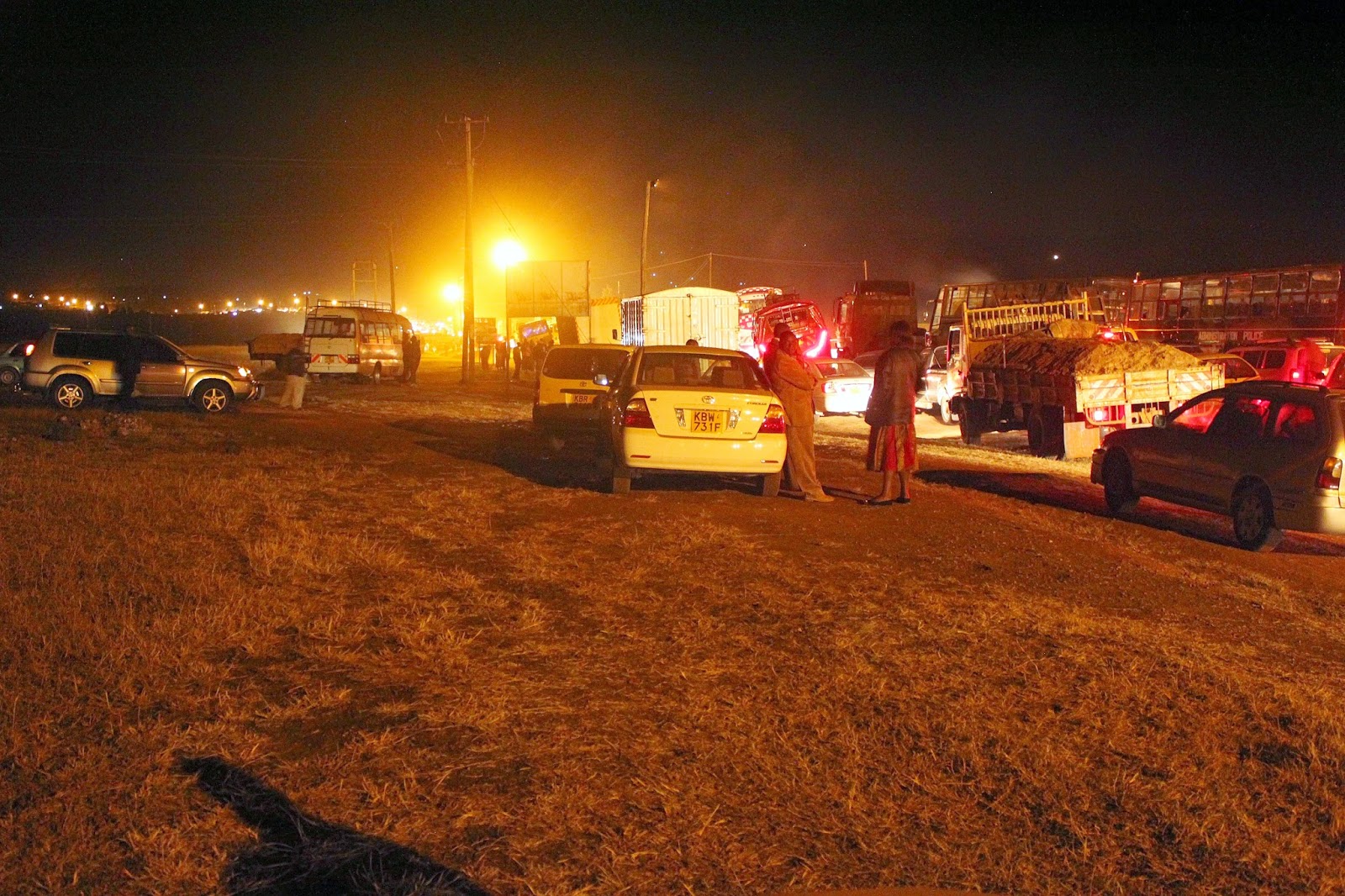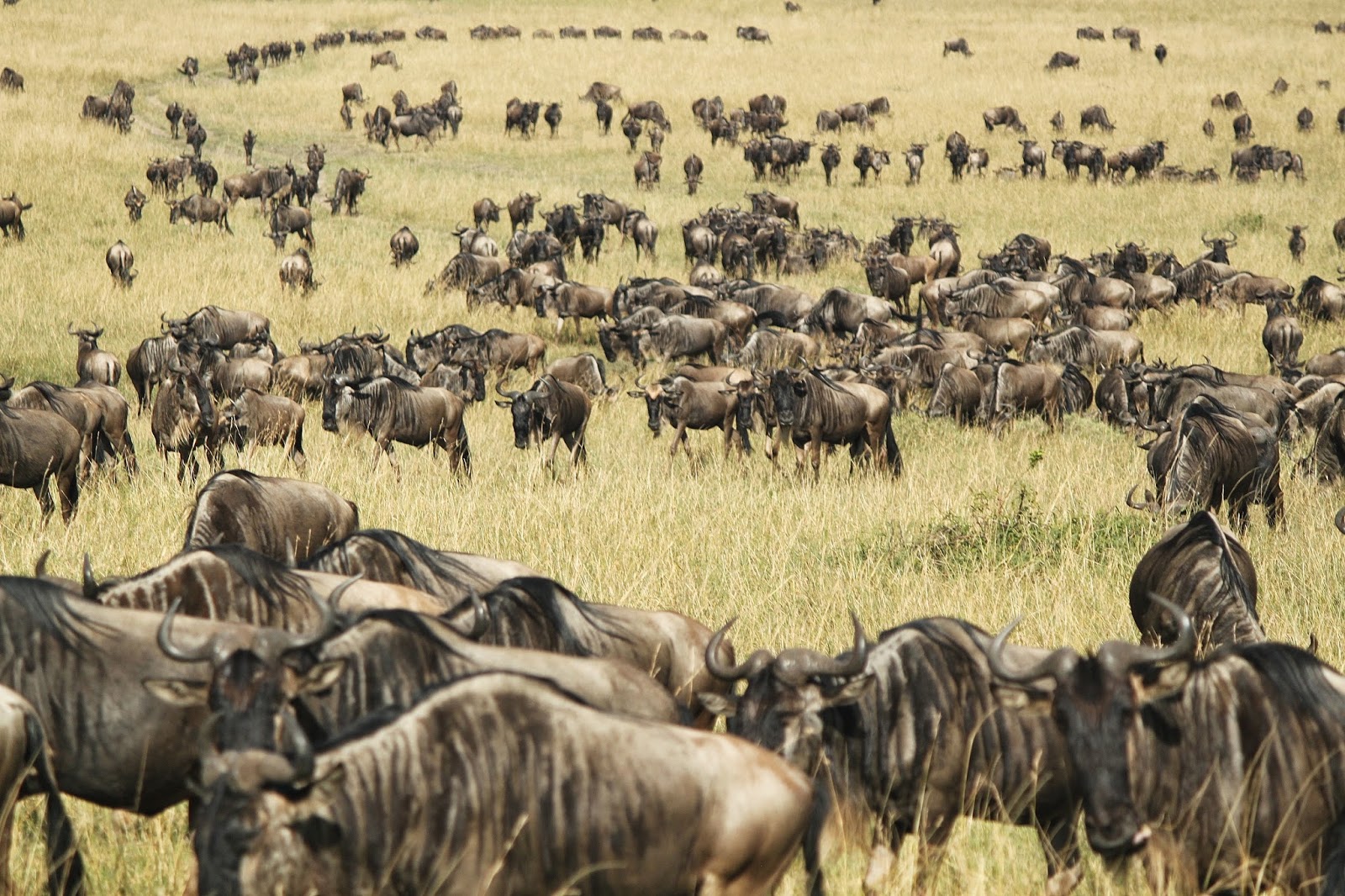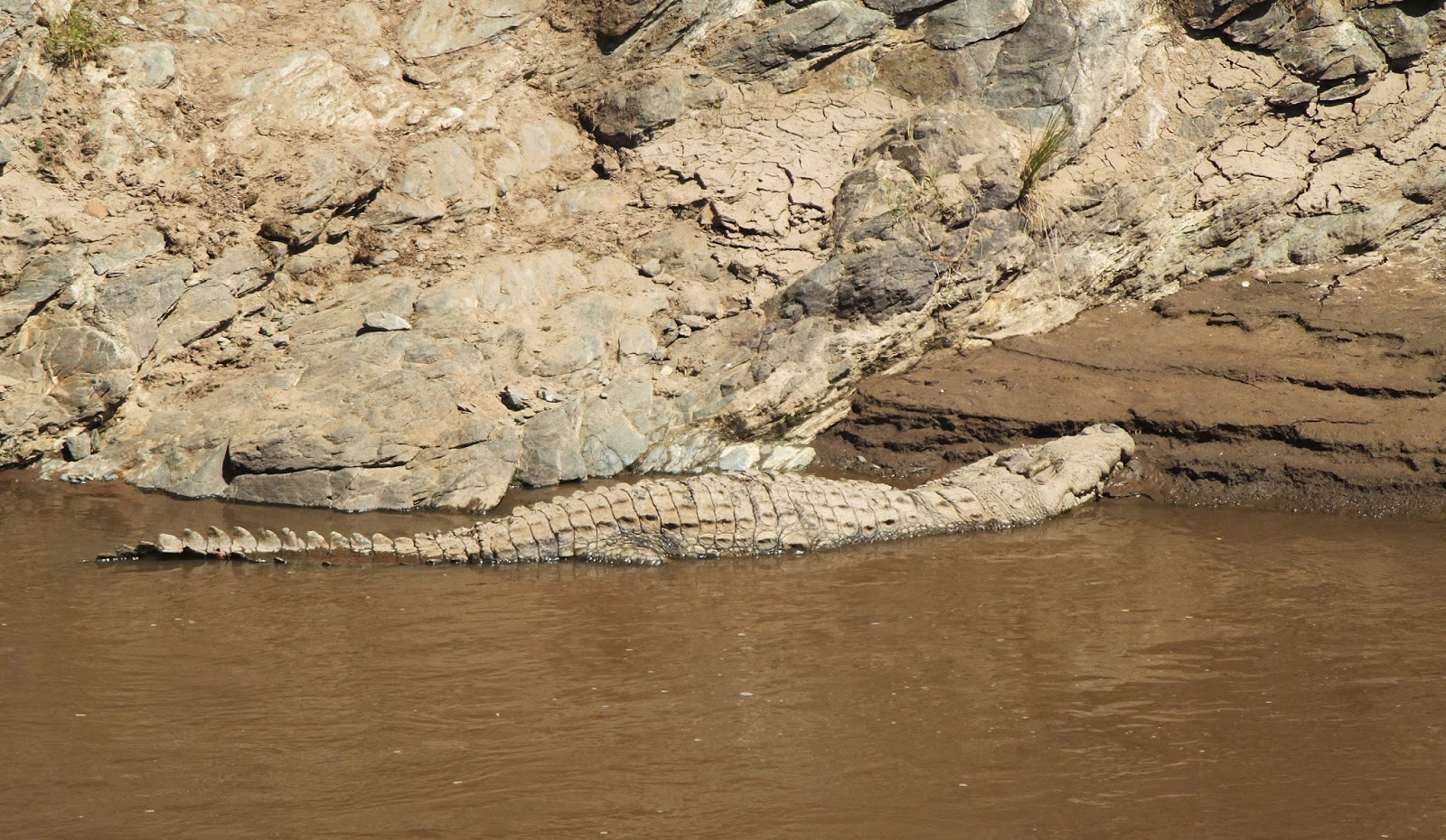 |
| Spending the night on the side of the highway. |
This month I was blessed to have visitors here in
Kenya. My parents and my good friend
Carol came to see me in Kenya for 1½ weeks.
For me, the adventure started before I even met up with them in Nairobi. It was not an easy journey getting to Nairobi. The trip from Mutomo to Nairobi usually takes
4-5 hours. This time, it took 18
hours!! While en route to Nairobi, we
(the driver and me) got caught in a major traffic jam near the town of
Machakos. The town was hosting a major
rugby tournament which drew many fans from Nairobi. The traffic on the road crawled along for an
hour or so before coming to a complete standstill. When it was clear that we wouldn’t be going
anywhere that night, everyone on the road shut off their engines and settled
down for the night. We didn’t move again
for seven hours! The grassy field on the
side of the road made for a convenient public toilet. The driver and I managed to catch a few hours
of uncomfortable sleep in the freezing car.
The original plan was for me to meet my parents at the airport in
Nairobi around 9pm. Instead, I had to call
and arrange for another taxi to pick them up while we were still on the
road. I didn’t manage to meet them at
the hotel until 6am the next morning! The
traffic jam was a huge event and even made the newspapers the next day. Luckily that was the only real snag. The rest of our trip went flawlessly.

 |
| Lion being chased away by an elephant. |
After spending a day together in Nairobi, we set off for a
safari in Maasai Mara game reserve. I’ve
been on six safaris now in Kenya (more than enough), but this one topped them
all. When tourists come to Kenya to see
wildlife, Maasai Mara is the first choice for most people. I finally got to see the elusive lions and
cheetahs. On our first afternoon in the park
we came across a female lion preparing to attack an antelope. Unfortunately for us tourists and the lion
(but not for the antelope) a nearby elephant felt threatened and chased the
lion away just as she was about to make her move. Just a few moments later we came across a
male lion taking a nap. Occasionally he
would decide to wake up for a moment and lift his head to pose for a photo. Just down the road from the lions we spotted
a cheetah taking an afternoon stroll across the plains.
 |
| The inside of our luxury tent where we "camped." |
 |
| And FOOD! |
On our second day we drove to the Mara River to see
crocodiles and hippos. Along the way we
were able to view the immense wildebeest herd gathering for its upcoming
migration across the river. What a
spectacular sight. Other highlights
included lion cubs, a pair of cheetahs feeding on a recently-killed gazelle,
and massive groups of elephants.
 |
| The gathering herd of wildebeest. In a few weeks, their numbers will peak at over 1 million. |
 |
| You can hardly see them when they are on the rocks. |
 |
| Lunch under the acacia tree. |
 |
| Wildebeest |
 |
| And another wildebeest... what's left of it. |
 |
| Baby elephants playing. |
 |
| Lion cubs with their mother. |
 |
| Traffic jams don't only happen in Machakos. Wherever there's a lion, safari vehicles aren't far behind. |
 |
| Cheetah feeding on a gazelle. |
 |
| Vultures waiting their turn to feed on the same gazelle. |
 |
| Impala |
 |
| Enjoying roasted maize. |
 |
| Cooking burgers on July 4th |
After three days in Maasai Mara and one more night in
Nairobi, our tour of Kenya continued onward to Mutomo, arriving in the
afternoon just in time to celebrate July 4th. What a treat it was to have my family there
to celebrate an American holiday. During
our journey to Mutomo, we stopped at Kitui town, the last town before the paved
road ends. Luckily, Kitui has a
well-supplied supermarket where we were able to buy ground beef, hamburger
buns, and other essentials for an American Independence Day celebration. In Mutomo, I took my visitors on an afternoon
walk, showed them around town, and took them through the market as we did a bit
of last-minute shopping for our meal.
 |
| The tacky American-flag visors were my mom's contribution from home. |
 |
| Enjoying Independence Day burgers, chips, maize, beans, and pineapple. |
 |
| First time I've found ice cream in Mutomo. A vendor brought it in from another town. |
 |
| Giving the tour of the hospital. |
|

On Saturday, we were invited by Fr. George to visit one of
the small outstations of Mutomo Parish (like a small satellite from the main
church building) located in Nduluni. The
congregation in Nduluni currently meets in a temporary structure of mud and
sticks with a tin roof and dirt floor.
On the day of our visit, the church was having a harambee (a fundraiser) to raise funds for a new building. Fr. George had told the congregation prior to
his visit that if they wanted him to visit, they were to bring him chickens as
gifts. And so after the service, people
walked up the aisle one after another and presented the pastor with live
chickens. Finally, with about 10
chickens collected, Fr. George announced that he wasn’t going to keep them for
himself, but was going to sell them back to the congregation at auction and
give the money back to them to help them build their church. Depending on the size, chickens usually go
for around 400-600kshs each (around $6).
But being a fundraising event, people were very willing to pay more, and
some chickens were going for close to 1000kshs.
The congregation even put up money to bid for chickens on behalf of
Carol and me, and at the end of it all we each walked away with a live chicken
of our own. It was a fun experience,
unlike any church fundraiser I’ve seen at home, and the people were very kind
in welcoming us into their church.


 |
| Carol with her chicken. |
 |
| And me with mine. |
 |
| The temporary church building in Nduluni. |
Sunday morning saw us back in Mutomo and visiting Holy
Family Primary School. It’s always fun
to watch the students react to seeing foreigners in Mutomo. The head teacher, Alfonse Malika, gave us a
classroom-by-classroom tour of the school.
In each class the students asked us questions about America: “What is
the climate like in America?” “How much
does it cost to fly to Kenya from America?”
“Who was the first president of America?” For this last question, my dad had a $1 bill
handy to show them George Washington’s picture.
I’ve never seen people so fascinated by a dollar. In fact, I think they were more interested in
the dollar than they were in us.
 |
| Examining a $1 bill. |
 |
| My mom, the mwalimu (teacher). |
 |
| Taking a walk through the Mutomo market. |
 |
| Enjoying the famous hospitality of my neighbor Anita. |
 |
| My dad, me, Anita, Sr. Mary, and my mom. |
At last their trip came to an end. We had a great nine days together and it was sad saying goodbye, but I'll be seeing them at home again in just three months.
 |
| Out for a run in Mutomo along the Syunguni road. |
 |
| Posing with a couple of my patients and their families. |
Today at work I discharged two of my patients from the
surgical ward who I’ve been caring for over the past week. Despite the communication barrier, I am
somehow able to work with them, and they get a bit of free entertainment in
listening to me fumble with my broken Kiswahili. One of them was admitted earlier with a knife
wound to the back, which I don’t have to tell you was extremely painful. So I was shocked when I showed up to work in
the morning to find the night nurse was only managing this pain with
ibuprofen! Thank God I was able to find
a doctor quickly and we had her on opioids within the hour (which is fast for
our hospital). I’m happy to say she’s
recovering well and can now be managed as an outpatient. Before leaving, they allowed me to take a
photo with them.
A couple months ago, I mentioned in a blog entry that I was
caring for a boy admitted with severe burns following an epileptic attack. Happily, he too has been sent home this past
week. He underwent extensive skin
grafting. I’ll miss working with
him. Despite being just a kid, he always
wore a smile on his scarred face and handled the entire ordeal better than most
American adults would. Like most
patients here in Mutomo, he faced his challenge with astounding patience and
perseverance.
 |
| Inside of the ambulance. We recently sent a stroke patient to Nairobi via ambulance. The only reason for using the ambulance was for the patient to have access to oxygen, but when the ambulance arrived we found that they had no oxygen! So we had to loan them one of our own oxygen tanks (seen against the back wall). |
A few weeks ago, it seemed every other patient admitted had
a diagnosis of meningitis. This week
seems to be diabetic week. The ward has
been flooded with diabetic patients who come in with their blood sugars skyrocketing. As a hospital, we tend to be pretty poor at
managing diabetes. Luckily, this week we
have a doctor visiting from the next-door government health center doing the
ward rounds. She’s knowledgeable, very
efficient, and has really taken charge in a few of the more difficult cases,
managing the dosing of insulin and other medications. I’m hoping we can have the patients’ blood
sugars stabilized quickly. Dealing with
diabetic patients both in America and in Kenya requires a lot of time to be set
aside for education. Diet education is a
huge challenge. Often, neither the
patients nor the nurses know much about a healthy diet. For example: there is a common belief among
the nurses that as long as a diabetic eats “brown bread” (wheat bread) instead
of white bread, they can eat as much of it as they want. For the past week I’ve been dealing with one
patient whose blood sugars are always soaring high (often well over 350). After a while, I noticed every time I saw him
he was eating bread. It turns out he’s
been eating one or two loaves of “brown bread” every day in addition to the
standard meals provided by the hospital.
I had to explain to the nurses that he had to stop eating so much because
“brown bread” also causes the blood sugar to increase; this news seemed to
really shock them. Today I spent my
afternoon teaching another diabetic patient how to self-inject himself
with insulin. I was fortunate that he
was able to speak English fairly fluently, otherwise the task would have been
impossible.
For the last two weeks now, I’ve been spending a great deal
of time with one critical patient. She’s
the type of patient who needs attention almost every hour. In the U.S. she might even be placed in the
ICU, but here there’s no such thing as an ICU.
She has multiple problems currently, but the most concerning has been
acute renal failure, possibly due to severe dehydration with nausea and
vomiting and poor intake of fluids. When
I first met her, she was nearly comatose, and even when she was awake she was
completely confused. Though still very
sick, this patient has made remarkable progress. She is now awake and talking, with minimal
confusion. Her renal function has
greatly improved. At its highest measured
level, the creatinine (an indicator of kidney function) was 9.3 (extremely
high). Over the course of this week, it
has decreased daily. Yesterday is was at
2.7 (still high, but great progress).
We’re playing a delicate game of balancing her hydration and kidney
function, her hemoglobin levels, and her electrolytes. She has to be manually fed every hour through
a nasogastric tube (no fancy automated machines like in the U.S.). I’m grateful that she has an extremely
supportive family. They are always at
the bedside, cleaning her, exercising her, and making sure that I come on time
to feed and hydrate her. And they even speak
English! In fact, they’ve been insisting
that I learn more Kiswahili and have been trying to teach me more phrases. This past week I learned, “Ninataka kumpa
dawa” – “I want to give medicine.” This
patient still has a long road to recovery, but I’m hoping for the best.
 |
| Kids often run through town with old wheels and tyres (that's how they spell it here). It actually looks kind of fun. |
 |
| Recently had a group of nurses over to dinner to try "mzungu spaghetti." People here usually make spaghetti with oil or margarine and then add tomatoes, potatoes, avocados, etc. When they first saw it they seemed a bit hesitant to try it. But after the first taste they seemed to enjoy it a lot. |










































































